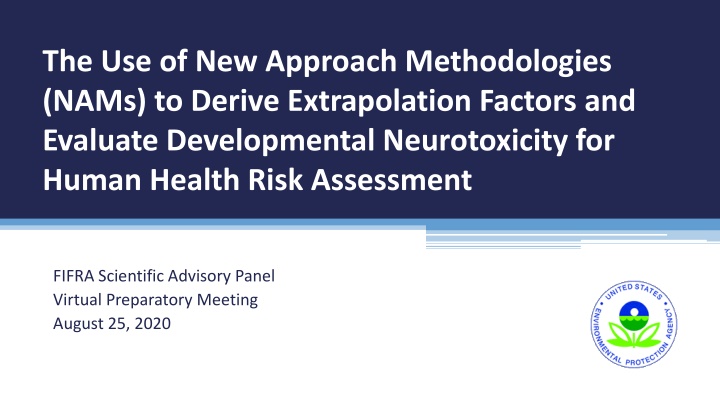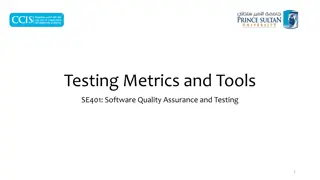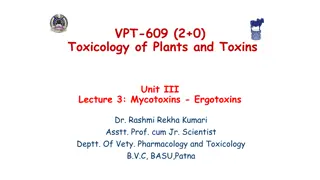Advancements in Non-Animal Testing for Neurotoxicity Assessment
New Approach Methodologies (NAMs) are being developed to evaluate developmental neurotoxicity without the use of animal testing. The EPA is prioritizing efforts to reduce animal testing and is actively supporting the development of NAMs. These methodologies involve using in vitro assays to assess critical processes of neurodevelopment, such as acetylcholinesterase inhibition data. Challenges with current neurotoxicity testing guidelines have led researchers to focus on targeted testing based on common modes of action, shifting away from traditional guideline studies. Platforms like Microelectrode arrays and High-content imaging are being utilized to understand neuronal network formation and key neurodevelopmental processes, respectively.
Download Presentation

Please find below an Image/Link to download the presentation.
The content on the website is provided AS IS for your information and personal use only. It may not be sold, licensed, or shared on other websites without obtaining consent from the author.If you encounter any issues during the download, it is possible that the publisher has removed the file from their server.
You are allowed to download the files provided on this website for personal or commercial use, subject to the condition that they are used lawfully. All files are the property of their respective owners.
The content on the website is provided AS IS for your information and personal use only. It may not be sold, licensed, or shared on other websites without obtaining consent from the author.
E N D
Presentation Transcript
The Use of New Approach Methodologies (NAMs) to Derive Extrapolation Factors and Evaluate Developmental Neurotoxicity for Human Health Risk Assessment FIFRA Scientific Advisory Panel Virtual Preparatory Meeting August 25, 2020
New Approach Methodologies (NAMs) Broad term referring to any non-animal technology, methodology, approach, or combination thereof that can be used to provide information on chemical hazard and risk assessment EPA has supported the development and implementation of non-animal testing, with the EPA Administrator signing a directive in 2019 that prioritizes efforts to reduce animal testing https://www.epa.gov/environmental-topics/administrator-memo-prioritizing-efforts-reduce-animal- testing-september-10-2019 EPA s Office of Pesticide (OPP) is actively engaged in numerous activities to develop NAMs and gain confidence in these technologies to supplement or replace existing toxicity tests
Scientific Advisory Panel (SAP) Meeting Virtual meeting to be held September 15-18, 2020 Two applications of NAMs being presented to the SAP Development of NAMs to evaluate developmental neurotoxicity (DNT) Use of in vitro acetylcholinesterase (AChE) inhibition data to develop data-derived extrapolation factors (DDEFs)
Development of NAMs to evaluate DNT Several challenges and limitations associated with the current DNT guideline study EPA has shifted its testing focus from the DNT guideline study to more targeted testing based on commonly accepted modes of action (MOA) Researchers in EPA s Office of Research and Development (ORD) are part of an ongoing international effort to develop in vitro assays that assess critical processes of neurodevelopment ORD collaborating with investigators funded by European Food Safety Authority (EFSA) to evaluate a battery of in vitro DNT assays Assays developed by both ORD and EFSA-funded researchers will provide a battery which covers critical processes in neurodevelopment
Development of NAMs to evaluate DNT Assays developed by ORD use two primary technology platforms from these ongoing efforts: Microelectrode arrays (MEAs) with multiple neural cell types to understand neuronal network formation High-content imaging (HCI) assays of neural cells to understand key processes relevant to neurodevelopment Human-derived neural models are used where feasible
Development of NAMs to evaluate DNT Organophosphate (OP) pesticides used as a case study in vitro to in vivo extrapolation (IVIVE) used to calculate administered equivalent doses (AEDs) for comparison to benchmark dose (BMD) values based on in vivo AChE inhibition in rodents IVIVE approaches based on high-throughput toxicokinetic measurements and models previously reviewed Any OP data from the EFSA-funded assays may be considered in combination with ORD assays in the future as part of an overall weight of evidence evaluation of the DNT potential for individual OPs EPA is not proposing any chemical-specific or class-based Food Quality Protection Act Safety Factors (FQPA SF) FQPA SF is a policy decision made by EPA that encompasses information beyond the scope of the NAM evaluation
Development of NAMs to evaluate DNT Soliciting comment from SAP on use of in vitro assays developed by ORD for evaluating DNT endpoints and the ability of the currently available battery of assays to cover critical processes in neurodevelopment Also soliciting comment on comparison of AEDs to BMD values based on AChE inhibition to predict relative sensitivity
Use of in vitro AChE inhibition data to develop DDEFs EPA s 2014 guidance on data-derived extrapolation factors (DDEFs) provides the foundation for using chemical specific or class specific information to replace the default interspecies and intraspecies extrapolation factors https://www.epa.gov/risk/guidance-applying-quantitative-data-develop-data-derived- extrapolation-factors-interspecies-and In vitro AChE inhibition data generated by academia on behalf of pesticide registrants for 16 organophosphate compounds used to calculate pharmacodynamic DDEFs
Use of in vitro AChE inhibition data to develop DDEFs Soliciting comment from the SAP on the study design and methods utilized to generate the in vitro data, statistical analyses employed to calculate DDEFs, and analyses performed for a small subset of OPs to evaluate contributions of experimental and intrinsic variability Ultimately, the selection and application of DDEFs for each chemical is a policy decision made by EPA
Charge Question #1 Using primary rat cortical neurons grown on microelectrode arrays (or MEAs), the EPA s Office of Research and Development has developed a network formation assay (NFA) to assess the potential impact of chemical exposure on neural network formation and function. Please comment on the strengths and limitations of using this assay to evaluate these endpoints as a component of neurodevelopment that may be susceptible to modulation by chemical exposure.
Charge Question #2 The EPA s Office of Research and Development has used high content imaging (or HCI) with a variety of rat- and human- derived in vitro models to investigate the potential impact of chemical exposure on cell proliferation, apoptosis, neurite outgrowth, and synaptogenesis. Please comment on the strength and limitations of using the HCI assays to evaluate these endpoints as components of neurodevelopment that may be susceptible to modulation by chemical exposure.
Charge Question #3 As discussed in Section 2.1 of the Agency s Issue Paper, EPA has shifted its testing focus from the developmental neurotoxicity guideline study to more targeted testing due to several challenges associated with the study and its limited impact on human health risk assessments for pesticides. New approach methodologies (or NAMs) provide an opportunity to overcome some of these challenges by evaluating underlying critical processes of neurodevelopment and incorporating human relevant information. NAMs covering critical processes in neurodevelopment developed by EPA s Office of Research and Development and researchers funded by the European Food Safety Authority are presented in Table 3 and Figure 2 of the Agency s Issue Paper. Based on this information and considering the goal of developing a NAM testing strategy or an integrated approach to testing and assessment (or IATA) within the next year for evaluating developmental neurotoxicity to inform chemical risk assessments, please comment on whether the critical processes related to the evaluation of developmental neurotoxicity are reasonably covered by this NAM battery.
Charge Question #4 Organophosphate pesticides share the ability to inhibit the acetylcholinesterase enzyme, which prevents the breakdown of acetylcholine leading to neurotoxicity. Inhibition of acetylcholinesterase is the basis of current OP human health risk assessments. In order to compare the relative sensitivity of the MEA NFA and HCI assay results to doses that inhibit acetylcholinesterase in laboratory animals, in vitro to in vivo extrapolation (or IVIVE) approaches were used to approximate NAM administered equivalent doses for a subset of organophosphate pesticides. Please comment on the strengths and limitations of this comparison and whether there are alternative approaches for this evaluation.
Charge Question #5 In vitro acetylcholinesterase inhibition data have been generated for rats and humans to develop interspecies and intraspecies data-derived extrapolation factors (or DDEFs) for pharmacodynamics for 16 organophosphate compounds in accordance with EPA s 2014 Guidance for Applying Quantitative Data to Develop DDEFs for Interspecies and Intraspecies Extrapolation. Please comment on the strengths and limitations of these data. Please include in your comments a consideration of the study design and methods, appropriateness of the selected measures, sufficiency of reporting, and robustness of the data, including sample size.
Charge Question #6 Given the structure of correlated data, nonlinear mixed-effects models were used to analyze the in vitro inhibition data in order to calculate the interspecies and intraspecies pharmacodynamic DDEFs. The ratios of the biomolecular rate constants between species or subpopulation were estimated from the nonlinear mixed-effects models. For a number of chemical-specific datasets analyzed by Exponent, the fitted non-linear mixed model generated warning statements due to a full rank final Hessian matrix. Additionally, for several of the chemical-specific datasets analyzed, visual evaluation of diagnostic plots revealed severe outliers or a severe imbalance in the distribution of residuals leading to questionable model fit. a) Please comment on the methods or techniques used in the nonlinear mixed-effects models. b) Please comment on any concerns associated with the warning statements and model-fit issues and suggest, if necessary, methods or techniques for addressing such warning statements and model-fit issues.
Charge Question #7 For the intra-species analyses, Exponent conducted stratified analyses, where the 18 human samples were subset into smaller groups to estimate the biomolecular rate constant ratios for these subgroups. EPA has concerns with the reliability of these stratified analyses due to the small sample sizes of the subgroups. Please comment on these analyses and their utility to evaluate intraspecies human variability in response to organophosphate exposure.
Charge Question #8 For intraspecies analyses, a limited subset of chemicals had three replicate analytical results on each of the four sources of human samples. The results from these analyses were used by Exponent to characterize the total variability of the estimates in terms of experimental variability and subject variability. The results were not consistent across the chemicals, ranging from 3% to 97% of the total variability due to differences in the replicate analyses. Please comment on the utility of these analyses.























